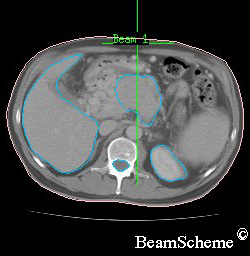Image guided radiotherapy (IGRT)
IGRT is short for image guided radiotherapy. It uses scans and x-rays to make sure that you're in the correct position for your radiotherapy treatment. You have them while you are on the radiotherapy couch, just before your treatment starts. Your radiographers check them against the scan you had at your planning appointment.
They might move the radiotherapy couch or your position after looking at the x-rays and scans. This is to make sure you're in a position very close (within millimetres) to your planning scan.
Sometimes you might have an x-ray or scan just after your treatment. You stay in the same position for this and it's used as another check.
X-rays show your bones in the treatment area. And scans show the size, shape and position of the cancer as well as the surrounding tissues and bones.

How does IGRT help?
In some areas of the body, cancers may move slightly during or between treatments. For example, the prostate gland changes position according to whether the bladder is full or not. You might also lie down in a slightly different position each day. So there is a risk that part of the cancer may be outside the treatment area for some treatment sessions.
Taking scans and x-rays just before your treatment, makes sure that you are in a position very close to your planning scan.
If your radiographers see from your first few images that your position is very similar each day, they may not need to take images every day.
4D-RT
4D-RT involves images being taken during your treatment. The radiotherapy machine can then adjust the position of the couch using information from these images.
In some types of 4D-RT the machine may switch off if the cancer moves out of the radiotherapy field. This type of treatment is helpful for cancers in areas of the body that move when we breathe, such as the lungs. The radiation beam switches on again when the cancer moves back into the right position. Your radiographers are always in control of the radiotherapy machine.
Having IGRT
Most external radiotherapy machines can deliver IGRT. A linear accelerator (LINAC) is the most common radiotherapy machine.
To have the treatment you lie on a radiotherapy couch. Your radiographers help you to get into the right position. They also put on any radiotherapy moulds or masks.

Once you are in the right position your radiographers leave you alone in the room. This is so they are not exposed to the radiation but they can see and hear you the whole time.
You can't feel anything when you have the treatment. It doesn’t hurt. It takes between 15 to 45 minutes.
Metal markers
You may have small metal markers (fiducial markers) put in or near your tumour. This is common for prostate cancer.
To place the markers, your doctor inserts a needle into the area of skin over the cancer. They do this while you are having an ultrasound scan. Once the tip of the needle is in the right place your doctor releases small gold pellets or rods.
Your radiographers can then see the markers on x-rays and scans while you're having treatment. They act as a marker for the treatment area, and makes sure that the treatment is very accurate. Your radiographers will take x-rays or scans every day before treatment if you have this type of metal marker.
Possible effects of IGRT
With IGRT, doctors can target the radiotherapy treatment area very accurately. So that there is less radiation to nearby healthy tissues. This can reduce your chance of side effects from radiotherapy. But taking images during treatment can:
- increase the length of time that you're on the radiotherapy couch
- be uncomfortable
- slightly increase the amount of radiation that you're exposed to
It's important to remember that this is still a very small amount compared to your treatment dose. Your doctor and radiographers make sure the benefits of taking the images outweigh the risks. This is the reason why you might not have scans and x-rays every day.



